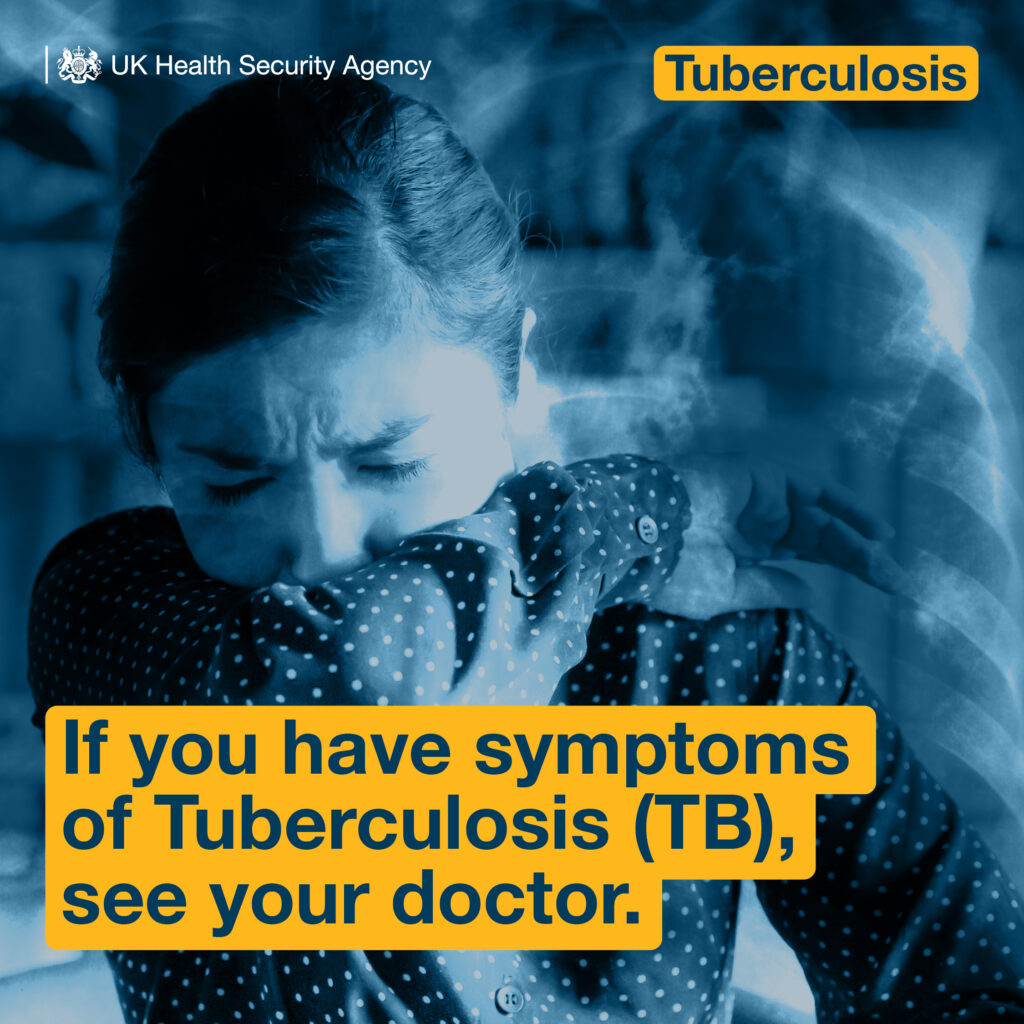
Tuberculosis (TB) is a bacterial infection spread through inhaling small droplets from the coughs or sneezes of an infected person. It mainly affects the lungs, but it can affect any part of the body, including lymph nodes (glands), bones and the brain causing meningitis.
Typical symptoms of TB include a persistent cough that lasts more than 3 weeks, unexplained weight loss, night sweats, high temperature, tiredness and fatigue, loss of appetite and depending on site of disease, swellings of lymph nodes in the neck or back pain if TB affects the spine.

It is a potentially serious condition, but it can be cured if it's diagnosed early and treated promptly with the right combination of specific antibiotics. The minimum length of treatment for non – drug resistant TB is a minimum of six months and much longer if treating a person with drug-resistant TB.
What is the situation with TB in England?
In England the story of TB prevention, detection and control has been a success -- with the incidence of TB falling significantly since 2011, when it was among the highest in western Europe with almost 9,000 cases recorded in that year.
However, in 2019 we saw that decline stop and instead, cases increased by 2.4%.
Between 2020 and 2021, the number of people notified in England increased by 7.3%. In 2021, a total of 4,425 people were notified with TB in England corresponding to a rate of 7.8 per 100,000 population. England remains a low incidence country.
The highest rates remain concentrated in large urban areas. For example, London accounted for 35.5% (1,569 out of 4,425) of cases, in 2021. The majority of people with TB in England were born in a country other than the UK. However, those diagnosed with TB and born in England were more likely to have a social risk factor (such as drug misuse, alcohol misuse, homelessness, or prison history). TB is strongly associated with deprivation.
Despite an overall downward trend in the number and rate of TB notifications in England during the last 10 years, the rate of decline is slowing. Unless this can be altered, England will fall short of achieving the World Health Organization’s End TB Strategy target of 90% reduction in people with TB from 2015 to 2035.
Who is most at risk?
Although almost anyone can get TB, the most at risk include those who live in, come from, or have spent time in a country or area with high levels of TB. Around three in every four TB cases in the UK affect people born outside of the UK.
Other at-risk groups include those who:
- Are in close contact with someone who is infected, e.g. living in the same house/flat
- Have a condition that weakens their immune system, such as diabetes and renal conditions.
- Are having treatments that weaken the immune system
- Are very young or very old
- Are in poor health or have a poor diet due to lifestyle and social risk factors, such as drug misuse, alcohol misuse, or homelessness
One way that we work to detect cases quickly, get people on the right treatment early and reduce the spread is through pre-entry screening for individuals from a high incidence country who wish to migrate to England. We also have free TB testing and treatment for people who are at risk but who might not have symptoms (this is known as latent TB infection) -- which can be accessed via a GP.
What are we doing to drive down TB cases?
TB continues to be a major cause of disease and death worldwide, being the second leading infectious killer after COVID-19. It is estimated that 10.6 million people became ill with TB and an estimated 1.6 million TB related deaths in 2021 (according to the WHO Global tuberculosis report 2022). The global increase in TB notifications and deaths in 2021 compared with 2020 is thought by WHO to be linked to disruption to TB services caused by the COVID-19 pandemic.
In 2015, the World Health Organisation (WHO) launched its ‘End TB Strategy’ which aims to reduce TB deaths by 95%, reduce new TB notifications by 90% and ensure that no family is burdened with catastrophic expenses due to TB by 2035 against 2015 levels; and eventually eliminate TB globally.
A second United Nations General Assembly High Level Meeting (UNHLM) on TB will take place in September 2023 with the aim to assess the impact of the COVID-19 pandemic on global TB elimination and review commitments made in 2018 at the first UNHLM on TB (PDF, 847 KB).
To enable the UK to meet its commitment to the World Health Organization (WHO) End TB by 2035 Strategy, UKHSA and NHS England launched a 5-year action plan in July 2021.
This will build on the improvements in the prevention, detection and control of TB in England over the past 10 years and focus on 5 key priority areas to provide partners with the tools to reduce TB incidence in all our communities.
The 5 priority areas are:
- Recovery from COVID-19
It is expected that missed and delayed diagnoses, late presentation of symptoms and delayed treatment will have increased the pool of undetected and unreported TB in the community, potentially leading to an increase in TB cases in the short term.
- Prevent and Protect
Prevent and protect susceptible people in England from acquiring TB infection and developing active disease. This will include increasing latent tuberculosis infection testing and offering the BCG vaccine to all those eligible within 4 weeks of birth.
- Detect TB
Improve early detection of TB by identifying, investigating and acting on the components that contribute to patient delay.
- Control TB disease
Prepare and respond to emerging threats from TB transmission clusters, outbreaks and incidents and drug resistant TB. This includes the rollout of the new National TB Surveillance System and the routine provision of whole genome sequencing data to TB services.
- Workforce
Develop and maintain the healthcare workforce to ensure workforce capacity to detect, case manage and control TB.
Read more information on the five year plan here and get more information on TB here.
